This was published 8 years ago
Tra Su Bird Sanctuary cruise, Vietnam: A piece of paradise
By Alison Stewart
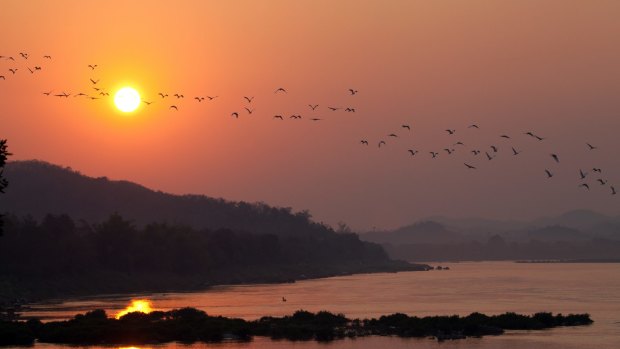
Birds at sunset, on the Mekong River.
We glide through mangrove forests with only the calls of birds and the swish of paddles to disturb the quiet. Yet the sense that we are entirely alone on the planet is tempered by the knowledge that we are in one of the world's most populous countries.
Vietnam's magical 1500-hectare Tra Su Bird Sanctuary, with its core 850 hectares of mainly cajeput (melaleuca) forest, is a gem in a country that crams 94 million people into a skinny dragon-shaped area less than half the size of NSW.
Add to that the environmental pressures of deforestation, overfishing and water pollution, and the existence of a unique area where nature dominates is even more remarkable.
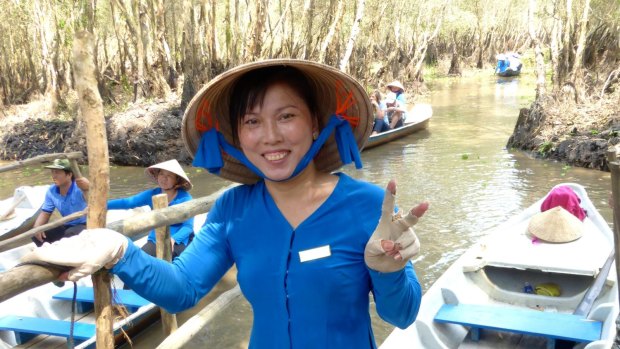
A canoe padler in Tra Su Bird Sanctuary's cajeput forest.Credit: Alison Stewart
We have come to this paradise – home to 140 types of flora, 70 species of birds, 11 types of animals, 25 species of reptiles, and 23 kinds of fish – as a "free choice" option on our Treasures of the Mekong luxury cruise through Cambodia and Vietnam.
Lengthy border crossing formalities completed – which apparently can sometimes involve officials bringing their families aboard for joyous photo opportunities – our sparkling new ship, Scenic Spirit, crosses into Vietnam's emerald Mekong Delta with its tangle of canals and rivers.
We leave the ship and, with our informative Vietnamese guide, Toan, we're transported by sampan to the Bassac (Hau Giang) River. A bus takes us through the culturally diverse town of Chau Doc with its significant Chinese, Cham and Khmer communities, through bright green rice paddies to the idyllic ecosystem that is Tra Su.
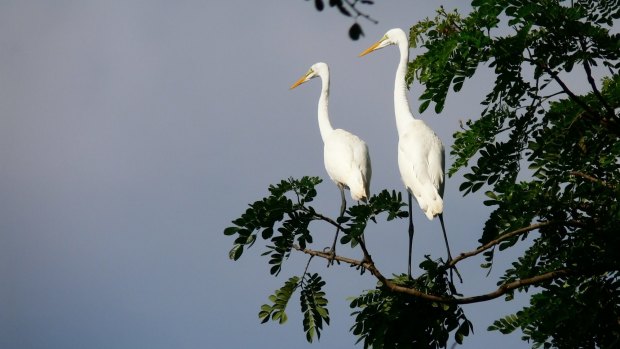
White storks.Credit: ExploringMekong.com
Today there is only peace, but this area just 10 kilometres from the Cambodian border, was once a place of conflict, both during the Vietnam War and the Khmer Rouge killing time. Only 25 kilometres away is a lotus-shaped memorial at Ba Chuc commemorating the 3157 villagers massacred by the Khmer Rouge in 1979.
Such horrors are past but not forgotten as we walk from the bus along a dirt road lined with blackbean, sugar palm, banana, jackfruit and papaya trees that takes us to the entrance to Tra Su. Ideally we would visit in the late afternoon, Toan tells us, as this is when the thousands of birds come home to roost.
The wet season is also the best time when the water level rises by two metres and the forest is entirely flooded – our visit falls during the dry (and in the morning). We are fortunate to be able to proceed as our shallow-draught motorboat becomes stuck in the mud, as does the one ahead of us. Our boatman asks us to shift around so he can dislodge us.
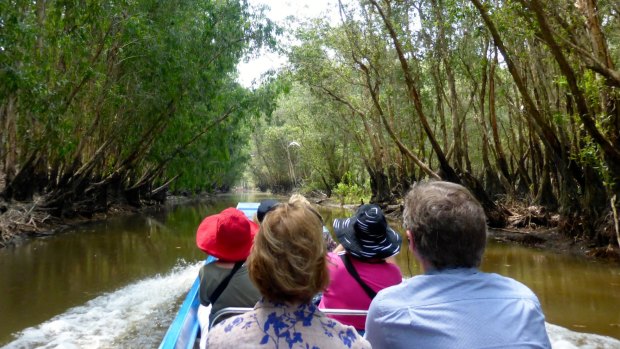
Bird spotting deep in the forest.Credit: Rob Mills
Deeper into the forest we go, the noise of the motorbikes that zoom the perimeter roads gradually fading. The birds are bolder here – openbill storks, herons, bitterns, kingfishers, cormorants, cattle egrets and a plethora of other wading birds tread lightly across the dense mats of Pistia or water lettuce whose soft green leaves resemble gigantic roses. There are thousands of birds sensibly keeping a safe perimeter of their own making, as are the bats, snakes and turtles that make this sanctuary home.
Waterlilies and lotus bloom vividly and dien dien bushes or Egyptian riverhemp that produce a yellow, edible flower shoulder the banks. We are encased in a green and watery world, weaving down winding canals sometimes under little bamboo-pole monkey bridges.
Our adventure isn't over. Our boatmen dock their blue-painted boats and we are led to three-person, wooden, shallow canoes paddled by boatwomen and men in blue traditional shirts and trousers and conical hats.
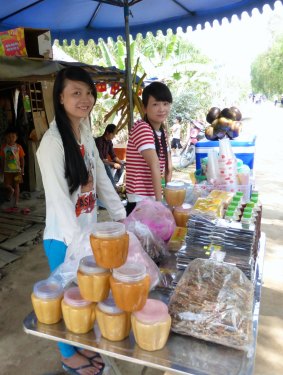
Khymer villagers sell palm sugarCredit: Alison Stewart
We're about to enter the heart of the forest – the densely packed cajeput with their intertwined roots, paperbark trunks and the duckweed carpeting the surface. Atop many of the trees are enormous beehives.
Thousands of nests rim the branches and we can only imagine the evening cacophony of birds coming home to roost. A conical hat might be a necessity rather than merely an ethnic fashion statement.
Toan says that during the wet season, the birds remain near their nests, as there's a plethora of fish in the cajeput mangroves.
The canals narrow and in the absence of nesting birds, the silence is deep, creating the impression of an enchanted forest.
There's a high observation tower in the centre of the reserve that gives excellent views across the mangroves and towards the Seven Mountain Range, Ket (Parrot) and Cam (Forbidden) mountains, but we run out of time.
Toan tells us that locals know how important this remnant of forest is but occasionally people will come in and fell trees. He says there is also a cultural desire to eat unusual creatures, which are sometimes illegally hunted. We see two men fishing, which is forbidden.
After we leave the sanctuary, there's time to visit a few homes belonging to the Khmer and Kinh people who live around the forest. They practise traditional crafts like brocade and Khmer silk production, sugar-making from the Palmyra palms, honey collection and cajeput oil extraction.
We taste the delicious fruit extracted from the brownish-black coconut-like fruit and sip the sweet sap tapped from the flower of the Cambodian national tree, the sugar palm, which is significant to the Khmer.
Roadside stalls sell dried catfish, palm sugar and bags of dried frog's legs but a late lunch beckons aboard the Scenic Spirit. Perhaps we'll wait.
TRIP NOTES
MORE INFORMATION
CRUISING THERE
Treasures of the Mekong 13-Day cruise from $6535 a person twin-share. Travel in 2017 and fly free return to south-east Asia, saving up to $3070 a couple. Business class upgrade from $2995 a person. Includes seven nights on board Scenic Spirit, visiting the colourful floating markets of Cai Be, the historic town of Sa Dec, and Cambodia's capital Phnom Penh. Plus three nights in Siem Reap, Cambodia and two in Ho Chi Minh City, Vietnam. See scenic.com.au
GETTING THERE
Vietnam Airlines fly from Sydney and Melbourne to Ho Chi Minh City (8hr 45min), then connect to Siem Reap (1hr). See vietnamairlines.com
Alison Stewart was a guest of Scenic.
Sign up for the Traveller Deals newsletter
Get exclusive travel deals delivered straight to your inbox. Sign up now.